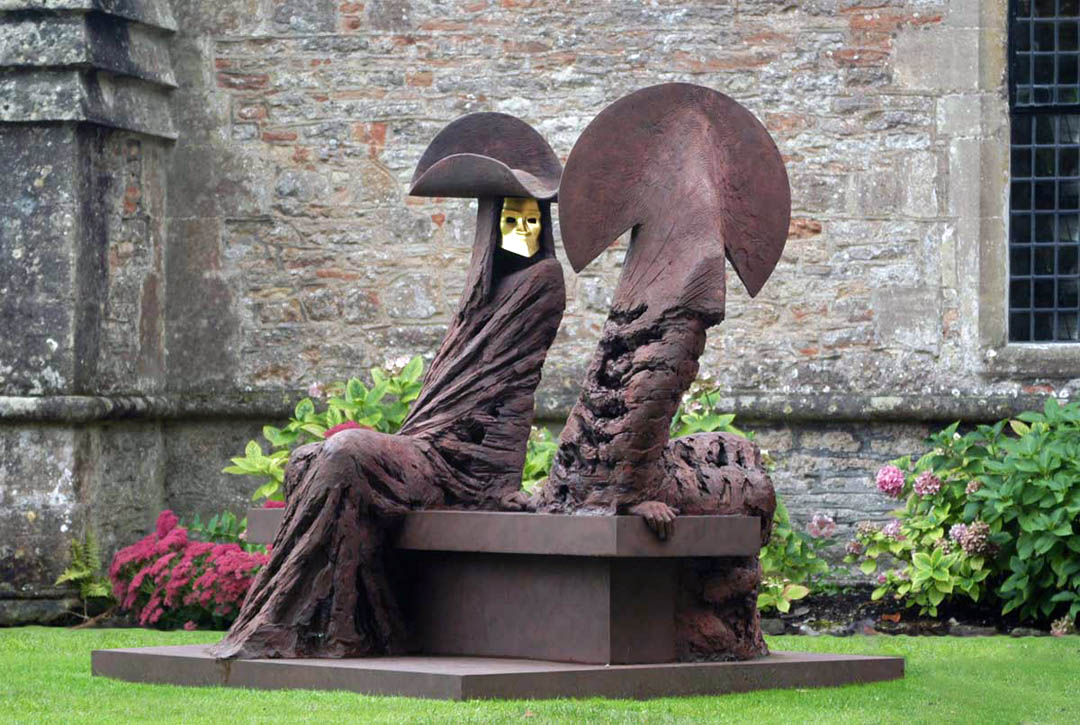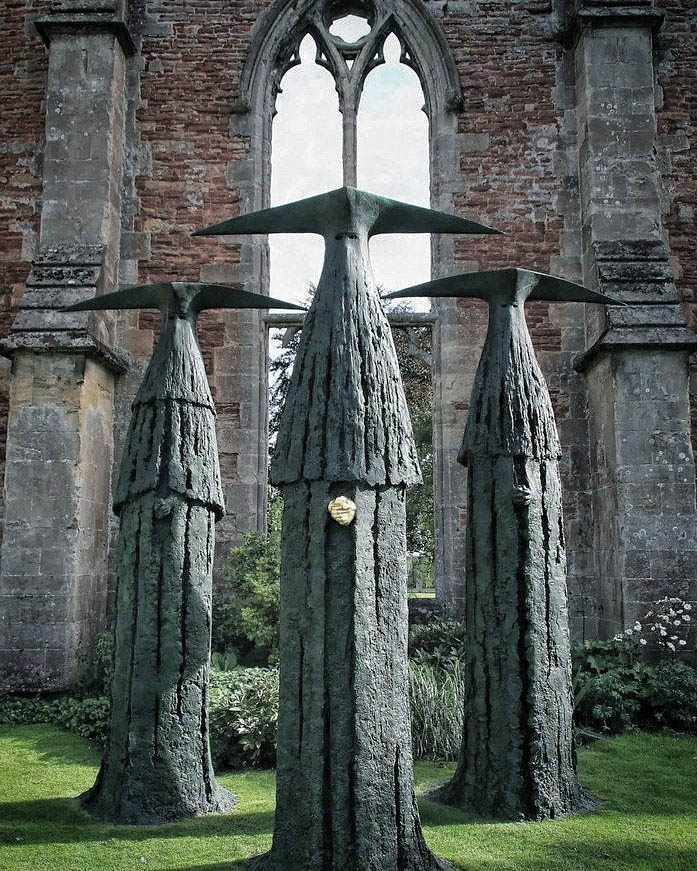This is some artwork that I immediately fell in love with. There’s something interesting going on within it; the artist has managed to embed postural and posing cues to a high degree, which affects this viewer by making me feel that I am looking at emotional displays.
Welcome to the work of Philip Jackson, “The Royal Court” sculptures.

Also, these are bronzes. The mold-maker in me quails at the sight of so much material, so beautifully rendered. The textures are amazing and that’s a hell of a lot of bronze!

Where I think Jackson’s work shines is the poses of the sculptures. They successfully convey some kind of emotion – or, perhaps, they convey that there is some kind of emotion and we fill in the blanks.

The use of different highlights and texture is exquisite. What is going on in the scene above? The figure in the center is being escorted somewhere, obviously. Is the trailing figure exhorting them to be brave because what is about to happen is terrible, or are they singing praises?

The body-language of the gossips above is just wonderful. The details like the hand clutching the bench make the piece effective.
Quoted in BetweenMirrors (where I found these photos) [bm] Jackson says:
“”My sculptures are essentially an impressionistic rendering of the figure. Where you see the figure seemingly grow out of the ground, the texture resembles tree bark, rock, or lava flow,” he’s said of his work. “As the eye moves up the sculpture, the finish becomes gentler and more delicately worked, culminating in the hands and the mask, both of which are precisely observed and modeled.”

I’ve always felt that headgear bears a particular relationship to displays of power. People seem to like big hats (or big hair) to raise their height and size when they are trying to look important. Jackson has a great grasp of posture and costume as means of projecting.

The figures above – you can tell they are serious about something. I assume they are a threat, because their faces are hidden. Tall figures with big hats and only their eyes showing are always menacing to me. These guys look like they are here to enquire seriously about the state of my soul. They won’t get their hands dirty but they have friends with hot tongs standing by to ask questions if I don’t answer promptly.
For me, great art is the stuff you can look at and either it tells you a story, or it makes you tell stories. I realize as I say that there’s an implicit bias in me toward art that is human-centric. Maybe that’s the reason why? I’m not sure. I’ve never found things like Mondrian or Jackson Pollock to be particularly interesting aside from “wow, that’s a bunch of colors”

I know this is silly, but I wish that sculpture gardens included information about the weight of the art-work, and how it’s mounted. Look at the angle on the woman above; she’s got to be mounted on some kind of deeply buried reinforced concrete thing, or she’d fall over. The angle in the piece is critical to its success, too, isn’t it? How much bronze are we looking at, what does that piece weigh, and how does it look so light and mobile anyway?

Yes. The earliest example of which I’m aware is the crown of Upper Egypt (later merged with the crown of Lower Egypt to create the dynastic crowns of united Egypt). It extends the whole head – unlike the Lower Egypt crown which anchors a narrow, artistic extension that does not mirror the shape of the head and does not come anywhere close to equaling the size of the head’s circumference. Though its “point” is rounded, it’s actually not dissimilar to a few hats Catholic popes have worn during the last couple thousand years.
More recently, there is the example of Padmé Amidala and the Naboo royalty more generally in the Star Wars prequels and Clone Wars animated series. They made it quite clear that expanding the size of the head was for the political representative, while the bodyguards and handmaidens wore hairstyles that kept much more close to the skull.
This work is vastly different in style from both the Hadjet (the Upper Egypt crown) and from the Star Wars hairstyles, with the broad and flat head coverings. I do see them as attracting attention and attempting to communicate importance, but subjectively they don’t communicate “authority” with that “importance”. It’s weird how I can absorb that message non-verbally. I wonder what other visual social clues I take in without noticing in the way that I did the “importance” signaling of the hats worn by these sculptures.
I’m sure it’s a lot of bronze anyway, but readers of your post shouldn’t mistake you for saying that these sculptures might be solid. It’s not THAT much bronze, as I know you know. The question is how thick would the skin of the statue need to be to survive the casting and detailing processes, and how much supporting architecture would there need to be for the sculpture to hold itself up (assuming that the skin itself wasn’t made thick enough to do that job on its own).
I’ve been able to see some statues in the process of being assembled and it was terribly interesting. I don’t really know anything about the process however, not even how they go about deciding whether or not supporting architecture is necessary, much less how they decide where to put it and how it should be shaped and how thick it has to be.
If you end up with any of this information, be sure to post it as well!
I agree that these are really cool artworks.
Oddly enough, the first thing that came to my mind upon seeing these artworks (after “cool” and “beautiful” that is) has been gender stereotypes. The female figures are really feminine. That lady who is about to step into the water, pay attention to her pose, her hands and fingers are positioned in a stereotypically feminine pose, the way how she holds her dress, how her leg is positioned, those are all stereotypical details of a stereotypical pose. The same goes also for the lady who is closing/opening her dress behind her back. And the more masculine figures, those are menacing, threatening, with big and impressive hats. So here I am right now, pondering about how artists tend to exaggerate masculine and feminine appearance, poses, clothing, etc. stereotypical elements that are supposed to denote the gender of the human figure portrayed in some artwork.
Probably I started having these thought after seeing these artworks only because I have been primed to think about this topic—currently on freethoughtbogs there’s an ongoing discussing about the rights of transgender people, and thinking about transgender rights makes me think about gender stereotypes.
They look awfully catholic to me.
Ketil Tveiten@#3:
They look awfully catholic to me.
It’s one of those chicken/egg things: do the catholics have big hats and body-eradicating robes in order to project power, or are our touchstones for power projection based on pervasive catholic power memes?
I’m thinking Bene Gesserit.
Did that left-side gossiper steal Nathan Hevenstone‘s hat?
These are really cool. However some look quite menacing and I doubt I’d be happy to have one in my yard. The sculptor has really captured graceful human movement but some of the themes are a bit oppressive to me.
I always wanted to try casting bronze but never got the chance. It must be fascinating.
Wow, these are wonderfully evocative.
I’m getting a Handmaids Tale feeling from most of the set – a very oppressive society and, even though it isn’t actually depicted, there’s a palpable threat of violence in the narrative of the tall-hatted figures. And then there are the lithe, ultra-feminine and solitary figures in contrast. The juxtaposition is fabulous.
kestrel@#7:
I always wanted to try casting bronze but never got the chance. It must be fascinating.
Yeah, me too!
I worry about the stuff that they put in bronzes – there are a lot of alloys that have nasty stuff like lead and zinc in them, and when you’re dealing with “mystery bronze” I suspect it can be pretty dangerous.
A foundry suitable for making statuary… Dang, that must be quite a thing. There’s a place in Clearfield that does cannon barrels for reenactors and they said I could visit but not be in the area when they are pouring. It’s a huge old building. I assume that the gear required to do statuary-level stuff is pretty impressive. I’m also curious how they mold it and empty the molds. It can’t be lost wax at that size, I assume. I wonder if they sand cast it and then CNC it for cleanup or something.
I have to admit that I thought seriously about asking the guys in Clearfield if I could come work there, as a retirement project.
voyager@#8:
there’s a palpable threat of violence in the narrative of the tall-hatted figures
Yeah, I love that. It’s fascinating that the artist managed to transmit so much in the pose of a sculpture. There is no way the tall hatted figures are nice.
These are amazing. I love the second one the most.